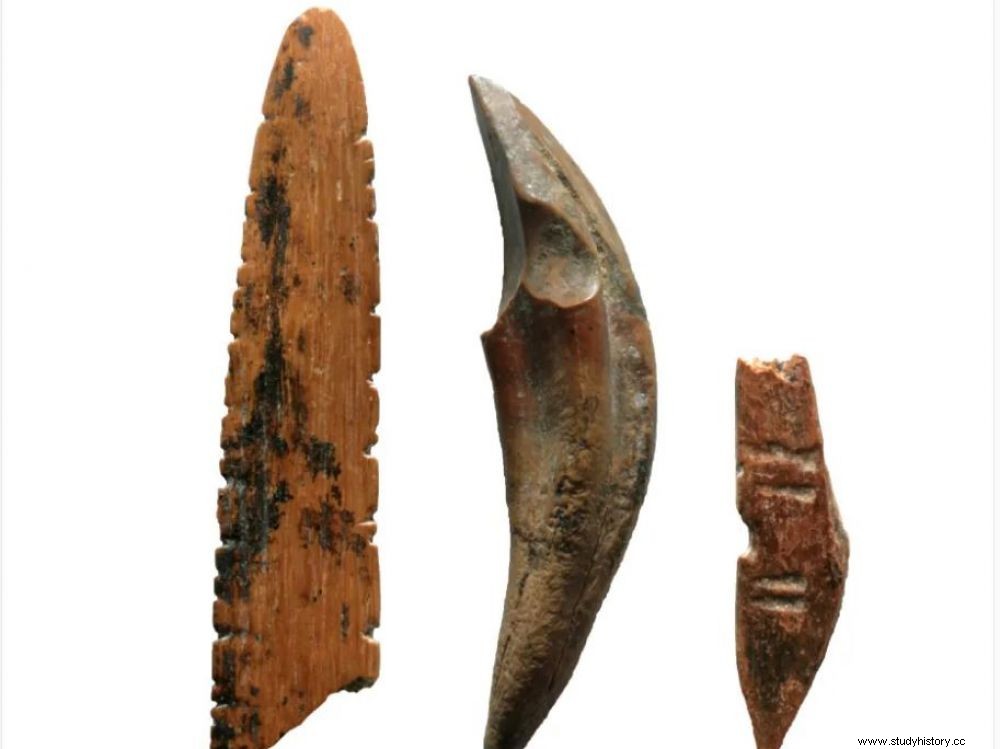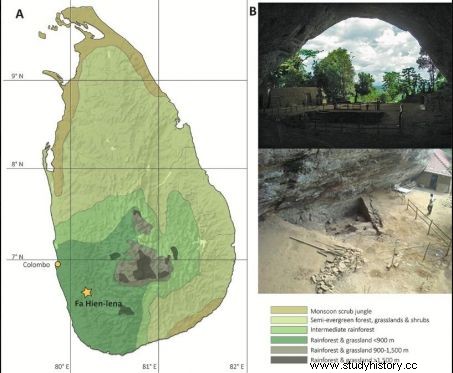The first evidence of the use of bows and arrows by prehistoric people outside the African continent has been attested in the tropical forests of Sri Lanka, in South Asia. They date back 48,000 years.

Shuttle, monkey tooth punch and arrowhead, from Fa-Hien La cave in Sri Lanka (45-48,000 years old).
More than a throw of an arrow… It is to the west of the island of Sri Lanka, the former Ceylon, in the Indian Ocean, that the oldest testimonies of bowhunting identified outside Africa, would have been unearthed in the cave of Fa Hien Lena. In a study published in the journal Science Advances, an international team of researchers from the Max Planck Institute for the Science of Human History (MPI-SHH) in Germany, Griffith University in Australia and the Government of Sri Lanka's Department of Archeology, have provided the evidence of early bow and arrow use with the discovery of bone-cut points, found alongside an abundance of remains - ochre-coloured beads, tools for treating hides for making clothes, or braiding nets - all found in archaeological levels dating back 45-48,000 years.

Bone tools, teeth, and carved arrowheads (lower right) found in Fa Hien Lena Cave, Sri Lanka. Credits:Langley et alii
Famous since the 1980s for concealing the presence of human fossils from the Upper Pleistocene, the vast cavity of the Kalutara district, one of the most important archaeological sites in South Asia, is once again making headlines. Between 2009 and 2012, archaeologists would indeed have collected there, nearly 130 projectile points showing traces of impact and fractures "compatible with hunting damage" , explains Michelle Langley, co-author of the research. Notches and wear revealed during examinations carried out using microscopes, on these arrowheads carved on the bones of boar, deer or even primates.

Map of Sri Lanka with location of the site of Fa-Hien Lena. On the right, the cavity, and the area where the archaeological remains were discovered. Credits:Wedage et alii.
The invention of the bow and arrow was one of the great technological innovations of Paleolithic hunting societies. It allowed humans to reach all kinds of prey, without having to get too close. In particular, when it came to catching large terrestrial or aquatic animals, or other arboreal, smaller ones, like monkeys in tropical areas. Not to mention the birds, often perched high in the canopy. A weapon used for food but also for war. When was it invented? At what time ? These questions are still debated.

Cave paintings with archer on the walls of the site of Wadi Aouis, Acacus, Sahara Desert, Libya (North Africa). Philippe Roy, Aurimages / AFP
To date, the oldest evidence of bow and arrow use comes from Sibudu Cave, South Africa, where it is dated to around 64,000 years old. Outside this continent, arrows with bow fragments have also been found in Europe, especially in bogs. This is how remains of these 12,000 year old weapons were exhumed in Stelmoor, Germany, but unfortunately destroyed during the Second World War. Older, dating back to the Gravetian period (29,000 to 22,000 years ago), small points of cut stone, called microliths, encountered in abundance, could be survivals of bows and arrows. Some have even been preserved whole. Thus, in France, an arch of 4600 years before our era, cut in yew, was found on the quays of the Seine, during the excavations of the site of Bercy, in 1991.

A San hunter-gatherer in present-day Namibia. Credits:AFP
Either way, because these weapons are mostly made from perishable materials (wood, sinew, fibers), Fa-Hien Lena's small bone spikes are an important find. Today, many human groups continue to use bows and arrows to hunt, particularly in Amazonia, South Africa, or South and Southeast Asia.
